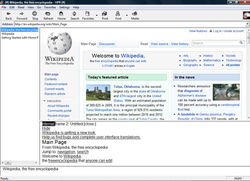 Home Page Reader 3.0 rendering Wikipedia. | |
| Developer(s) | IBM Special System Needs (SNS) |
|---|---|
| Final release | 3.04[1]
/ 2005 |
| Operating system | Windows 95/98/NT |
| Platform | Windows |
| Available in | English, French, German, Italian, Japanese, and Spanish[2] |
| Type | Screen Reader |
| Website | Homepage (Archive.org) |
Home Page Reader (Hpr) was a computer program, a self-voicing web browser designed for people who are blind. It was developed by IBM from the work of Chieko Asakawa at IBM Japan.
The screen reader met World Wide Web Consortium (W3C) HTML 4.01 specifications, Web Content Accessibility Guidelines 1.0 and User Agent Accessibility Guidelines 1.0.[3]
In 2006, it was announced on the Hpr mailing list that IBM does not have plans for any further updates of HPR and the software was subsequently withdrawn from sale by IBM in December 2006.[4] IBM has given code to be used as a Firefox extension.[citation needed]
The program also had a peer-support mailing list.[5][note 1]
YouTube Encyclopedic
-
1/5Views:77 503868 72163 7912 1681 003
-
Basic overview of the JAWS screen reader
-
How Old School Floppy Drives Worked
-
Punching Data on Computer Cards]
-
dW Cloud Trial: Creating an Application Workload service
-
Overview of Web Applications
Transcription
Criticism
In summer 2002 a non-scientific study concluded that Hpr did not make any distinction between the built-in keyboard shortcuts for entering different modes and the access keys available on websites. The research claimed that Hprs would do better to use links mode to cycle through a list.[6]
System requirements
Hardware
Hpr had the following hardware requirements:[7]
- 166 MHz processor
- 32 MB RAM Windows 95/98; 64 MB RAM for Windows NT
- 14 MB hard disk space; 42 MB hard disk space for HPR and Netscape Communicator
- SVGA (640 X 480, 256 colors) graphics
- Windows compatible: modem (28.8 KBPS), sound card (16-bit), and CD ROM drive (quad-speed)
- Integrated or separately attached numeric keypad
Software
Hpr had the following software requirements:[7]
- Microsoft Windows 95, 98 or NT 4.0
- Internet service provider (ISP) connection
- Netscape Navigator Version 3.01 or higher
- For Home Page Mailer, Microsoft Personal Web Server, Version 4.02 required for Windows 95/98; Peer Web Services, Version 4.0 required for Windows NT
- A mail program set up with preferences, or Microsoft Personal Web Server or Peer Web Services required for mailto: tags
References
- Notes
- ^ Its archives were available at http://www.talklist.com/forms/ibm-hpr[permanent dead link]
- References
- ^ "Home Page Reader Version 3 : Spectronics - Inclusive Learning Technologies". Archived from the original on July 29, 2010. Retrieved 10 August 2010.
- ^ "IBM relaunch browser for the blind". evolt.org. Archived from the original on 27 October 2016. Retrieved 10 August 2010.
- ^ "IBM Home Page Reader 3.04". IBM. 2007. Archived from the original on 30 December 2006. Retrieved 10 August 2010.
- ^ faulkner, steve (November 7, 2006). "IBM Home Page Reader is Dead". AOL Ability. Archived from the original on 7 January 2007. Retrieved 10 August 2010.
- ^ "BLIST: The Comprehensive Index of Blindness-Related Emailing Lists". June 20, 2002. Retrieved 10 August 2010.
- ^ "Using Accesskeys - Is it worth it?". wats.ca. October 2006. Archived from the original on 2007-06-30. Retrieved 7 January 2011.
- ^ a b "IBM Home Page Reader". Archived from the original on 3 February 2013. Retrieved 10 August 2010.
External links
- HomePage reader @ evolt.
- HPR ftp directory, IBM
- IBM Home Page Reader Keyboard Shortcuts, WebAIM
- IBM Home Page Reader Tutorial, WebAIM
